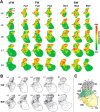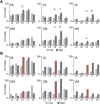Distribution of Spinal Neuronal Networks Controlling Forward and Backward Locomotion
- PMID: 29678875
- PMCID: PMC5956987
- DOI: 10.1523/JNEUROSCI.2951-17.2018
Distribution of Spinal Neuronal Networks Controlling Forward and Backward Locomotion
Abstract
Higher vertebrates, including humans, are capable not only of forward (FW) locomotion but also of walking in other directions relative to the body axis [backward (BW), sideways, etc.]. Although the neural mechanisms responsible for controlling FW locomotion have been studied in considerable detail, the mechanisms controlling steps in other directions are mostly unknown. The aim of the present study was to investigate the distribution of spinal neuronal networks controlling FW and BW locomotion. First, we applied electrical epidural stimulation (ES) to different segments of the spinal cord from L2 to S2 to reveal zones triggering FW and BW locomotion in decerebrate cats of either sex. Second, to determine the location of spinal neurons activated during FW and BW locomotion, we used c-Fos immunostaining. We found that the neuronal networks responsible for FW locomotion were distributed broadly in the lumbosacral spinal cord and could be activated by ES of any segment from L3 to S2. By contrast, networks generating BW locomotion were activated by ES of a limited zone from the caudal part of L5 to the caudal part of L7. In the intermediate part of the gray matter within this zone, a significantly higher number of c-Fos-positive interneurons was revealed in BW-stepping cats compared with FW-stepping cats. We suggest that this region of the spinal cord contains the network that determines the BW direction of locomotion.SIGNIFICANCE STATEMENT Sequential and single steps in various directions relative to the body axis [forward (FW), backward (BW), sideways, etc.] are used during locomotion and to correct for perturbations, respectively. The mechanisms controlling step direction are unknown. In the present study, for the first time we compared the distributions of spinal neuronal networks controlling FW and BW locomotion. Using a marker to visualize active neurons, we demonstrated that in the intermediate part of the gray matter within L6 and L7 spinal segments, significantly more neurons were activated during BW locomotion than during FW locomotion. We suggest that the network determining the BW direction of stepping is located in this area.
Keywords: backward and forward walking; c-Fos; decerebrate cat; locomotor networks.
Copyright © 2018 the authors 0270-6474/18/384695-13$15.00/0.
Figures








Similar articles
-
Activity of Spinal Interneurons during Forward and Backward Locomotion.J Neurosci. 2022 Apr 27;42(17):3570-3586. doi: 10.1523/JNEUROSCI.1884-21.2022. Epub 2022 Mar 16. J Neurosci. 2022. PMID: 35296546 Free PMC article.
-
Neuronal mechanisms underlying activation of locomotor network by epidural electrical stimulation of the spinal cord.Exp Neurol. 2025 May;387:115187. doi: 10.1016/j.expneurol.2025.115187. Epub 2025 Feb 18. Exp Neurol. 2025. PMID: 39978566 Free PMC article.
-
Locomotor-activated neurons of the cat. I. Serotonergic innervation and co-localization of 5-HT7, 5-HT2A, and 5-HT1A receptors in the thoraco-lumbar spinal cord.J Neurophysiol. 2009 Sep;102(3):1560-76. doi: 10.1152/jn.91179.2008. Epub 2009 Jul 1. J Neurophysiol. 2009. PMID: 19571190 Free PMC article.
-
Epidural stimulation: comparison of the spinal circuits that generate and control locomotion in rats, cats and humans.Exp Neurol. 2008 Feb;209(2):417-25. doi: 10.1016/j.expneurol.2007.07.015. Epub 2007 Aug 1. Exp Neurol. 2008. PMID: 17850791 Free PMC article. Review.
-
Neurophysiology of locomotor automatism.Physiol Rev. 1976 Jul;56(3):465-501. doi: 10.1152/physrev.1976.56.3.465. Physiol Rev. 1976. PMID: 778867 Review.
Cited by
-
Forward Stepping Evoked by Transvertebral Stimulation in the Decerebrate Cat.Neuromodulation. 2024 Jun;27(4):625-635. doi: 10.1016/j.neurom.2022.11.009. Epub 2022 Dec 23. Neuromodulation. 2024. PMID: 36567242 Free PMC article.
-
Differential activation of lumbar and sacral motor pools during walking at different speeds and slopes.J Neurophysiol. 2019 Aug 1;122(2):872-887. doi: 10.1152/jn.00167.2019. Epub 2019 Jul 10. J Neurophysiol. 2019. PMID: 31291150 Free PMC article.
-
Closed-loop cervical epidural stimulation partially restores ipsilesional diaphragm EMG after acute C2 hemisection.Respir Physiol Neurobiol. 2024 Feb;320:104182. doi: 10.1016/j.resp.2023.104182. Epub 2023 Nov 1. Respir Physiol Neurobiol. 2024. PMID: 37923238 Free PMC article.
-
Functional mapping of the lower urinary tract by epidural electrical stimulation of the spinal cord in decerebrated cat model.Sci Rep. 2024 Apr 26;14(1):9654. doi: 10.1038/s41598-024-54209-3. Sci Rep. 2024. PMID: 38670988 Free PMC article.
-
Hindlimb motor responses evoked by microstimulation of the lumbar dorsal root ganglia during quiet standing.J Neural Eng. 2019 Dec 23;17(1):016019. doi: 10.1088/1741-2552/ab4c6c. J Neural Eng. 2019. PMID: 31597128 Free PMC article.
References
-
- Arshavsky YI, Gelfand IM, Orlovsky GN (1986) Cerebellum and rhythmical movements. New York: Springer.
Publication types
MeSH terms
Substances
Grants and funding
LinkOut - more resources
Full Text Sources
Other Literature Sources
Miscellaneous
